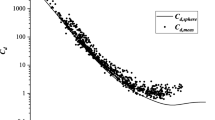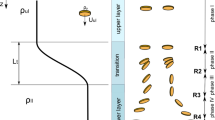Abstract
From the viewpoint of improving the visibility of water in small lakes and ponds, in a previous study, we treated turbidity-causing (TC) particles and adsorption agents. Brownian dynamics simulations were conducted for particles with a spherical shape in order to elucidate the adsorption performance of the agents in the gravitational field. The technique for the adsorption is based on the use of the translational Brownian motion of the adsorption particles. If non-spherical particles are used as adsorption agents, then rotational Brownian motion is also expected to make a significant contribution to the adsorption performance. In the present study, we have employed the modeling of large spherocylinder adsorption particles and small spherical TC particles with sub-micron size, in order to perform Brownian dynamics simulations in regard to adsorption and sedimentation in the gravitational field. For the case of adsorption particles with a low aspect ratio, the adsorption rate is not significantly different to the spherical particle case, with an improvement of only a few percent. This implies that the rotational Brownian motion hardly contributes to the adsorption performance. In contrast, for the case of a rod-like particle with a high aspect ratio, the adsorption rate is much better than that for the spherical particles, with an improvement of around 75%, and therefore it is seen that the effect of the rotational Brownian motion gives rise to a much more significant adsorption performance. This is mainly because with an increasing aspect ratio the opportunity for the agent particles to contact with the TC particles increases more significantly due to the effect of the rotational Brownian motion. From these results, we understand that rod-like particles with a high aspect ratio employed as adsorption agents are able to adsorb TC substances much more efficiently in comparison to spherical particles.












Similar content being viewed by others
References
Ahmed MA, Ali SM, El-Dek SI, Galal A (2013) Magnetite–hematite nanoparticles prepared by green methods for heavy metal ions removal from water. Mater Sci Eng B 178:744–751
An S, Julien PY, Venayagamoorthy SK (2012) Numerical simulation of particle-driven gravity currents. Environ Fluid Mech 12:495–513
Baylar A, Ozkan F (2006) Applications of venturi principle to water aeration systems. Environ Fluid Mech 6:341–357
Buscall R (1990) The sedimentation of concentrated colloidal suspensions. Colloids Surf 43:33–53
Dashtian K, Zare-Dorabei R (2015) Synthesis and characterization of functionalized mesoprous SBA-15 decorated with Fe3O4 nanoparticles for removal of Ce(III) ions from aqueous solution: ICP–OES detection and central composite design optimization. J Colloid Interface Sci 494:114–123
Ellahi R, Hussain F (2015) Clay settling in fresh and salt water. Environ Fluid Mech 15:147–160
Gauden PA, Terzyk AP, Kowalczyk P (2006) Some remarks on the calculation of the pore size distribution function of activated carbons. J Colloid Interface Sci 300:453–474
Georgoulas AN, Angelidis PB, Panagiotidis TG, Kotsovinos NE (2010) 3D numerical modelling of turbidity currents. Environ Fluid Mech 10:603–635
Girginova PI, Daniel-da-Silva AL, Lopes CB, Figueira P, Otero M, Amaral VS, Pereira E, Trindade T (2010) Silica coated magnetite particles for magnetic removal of Hg2+ from water. J Colloid Interface Sci 345:234–240
Hasanzadeh R, Moghadam PN, Bahri-Laleh N, Sillanpää M (2017) Effective removal of toxic metal ions from aqueous solutions: 2-Bifunctional magnetic nanocomposite base on novel reactive PGMA-MAn copolymer@Fe3O4 nanoparticles. J Colloid Interface Sci 490:727–746
Ismadji S, Bhatia SK (2001) Characterization of activated carbons using liquid phase adsorption. Carbon 39:1237–1250
Jiang L, Liu P, Zhao S (2015) Magnetic ATP/FA/Poly(AA-co-AM) ternary nanocomposite microgel as selective adsorbent for removal of heavy metals from wastewater. Colloids Surf A 470:31–38
Jung S, Spagnolie SE, Parikh K, Shelley M, Tornberg A-K (2006) Periodic sedimentation in a Stokesian fluid. Phys Rev E 74:035302
Kalia S, Kango S, Kumar A, Haldorai Y, Kumari B, Kumar R (2014) Magnetic polymer nanocomposites for environmental and biomedical applications. Colloid Polym Sci 292:2025–2052
Konicki W, Hełminiak A, Arabczyk W, Mijowska E (2017) Removal of anionic dyes using magnetic Fe@graphite core-shell nanocomposite as an adsorbent from aqueous solutions. J Colloid Interface Sci 497:155–164
Lan S, Wu X, Li L, Li M, Guo F, Gan S (2013) Synthesis and characterization of hyaluronic acid-supported magnetic microspheres for copper ions removal. Colloids Surf A 425:42–50
Lia K, Zenga Z, Xionga J, Yana L, Guoa H, Liua S, Daia Y, Chen T (2015) Fabrication of mesoporous Fe3O4@SiO2@CTAB–SiO2 magnetic microspheres with a core/shell structure and their efficient adsorption performance for the removal of trace PFOS from water. Colloids Surf A 465:113–123
Okai T, Sasada Y, Komino S, Tanaka S (2007) Improvement of water quality and control of blue–green algae growth by aeration. Annu Rep Kagawa Prefect Res Inst Environ Sci Public Health 6:29–36 (in Japanese)
Sajjadi SH, Goharshadi EK (2017) Highly monodispersed hematite cubes for removal of ionic dyes. J Environ Chem Eng 5:1096–1106
Satoh A, Taneko E (2009) Brownian dynamics simulations of a dispersion composed of two-types of spherical particles: for development of a new technology to improve the visibility of rivers and lakes. J Colloid Interface Sci 338:236–242
Satoh A (2003) Introduction to molecular-microsimulation for colloidal dispersions. Elsevier, New York
Satoh A (2010) Introduction to practice of molecular simulation. Elsevier, New York
Satoh A (2015) Sedimentation behavior of dispersions composed of large and small charged colloidal particles: development of new technology to improve the visibility of small lakes and ponds. Environ Eng Sci 32:528–538
Satoh A (2017) Modeling of magnetic particle suspensions for simulations. CRC Press, Cambridge
Takami Y, Murayama N, Ogawa K, Yamamoto H, Shibata J (2000) Water purification property of zeolite synthesized from coal fly ash. J Min Mater Process Inst Jpn 116:789–794 (in Japanese)
Tambo N, Watanabe Y (1979) Physical characteristics of flocs—I. The floc density function and aluminium floc. Water Res 13:409–419
Tian H, Liu F, He J (2014) Multifunctional Fe3O4@nSiO2@mSiO2–Fe core–shell microspheres for highly efficient removal of 1,1,1-trichloro-2,2-bis (4-chlorophenyl)ethane (DDT) from aqueous media. J Colloid Interface Sci 431:90–96
Tirado MM, de la Torre JG (1979) Translational friction coefficients of rigid, symmetric top macromolecules. Application to circular cylinders. J Chem Phys 71:2581–2587
Tirado MM, de la Torre JG (1980) Rotational dynamics of rigid, symmetric top macromolecules. Application to circular cylinders. J Chem Phys 73:1986–1993
Tirado MM, Mercedes CL, de la Torre JG (1984) Comparison of theories for the translational and rotational diffusion coefficients of rod-like macromolecules. Application to short DNA fragments. J Chem Phys 81:2047–2052
Vojoudi H, Badiei A, Bahar S, Ziarani GM, Faridbod F, Ganjali MR (2017) A new nano-sorbent for fast and efficient removal of heavy metals from aqueous solutions based on modification of magnetic mesoporous silica nanospheres. J Magn Magn Mater 441:193–203
Wedlock DJ, Fabris IJ, Grimsey J (1990) Sedimentation in polydisperse particulate suspensions. Colloids Surf 43:67–81
Wotton RS (2002) Water purification using sand. Hydrobiologia 469:193–201
Xia Z, Connington KW, Rapaka S, Yue P, Feng JJ, Chen S (2009) Flow patterns in the sedimentation of an elliptical particle. J Fluid Mech 625:249–272
Yang H, Zhang H, Peng J, Zhang Y, Du G, Fang Y (2017) Smart magnetic ionic liquid-based Pickering emulsions stabilized by amphiphilic Fe3O4 nanoparticles: highly efficient extraction systems for water purification. J Colloid Interface Sci 485:213–222
Acknowledgements
The authors would like to acknowledge the financial support from Grant-in-Aid for JSPS Fellows (18J21020).
Author information
Authors and Affiliations
Corresponding author
Additional information
Publisher's Note
Springer Nature remains neutral with regard to jurisdictional claims in published maps and institutional affiliations.
Rights and permissions
About this article
Cite this article
Okada, K., Satoh, A. Sedimentation characteristics of spherical and rod-like particles in the gravitational field by Brownian dynamics simulations: for the improvement of the visibility of small lakes and ponds. Environ Fluid Mech 20, 765–790 (2020). https://doi.org/10.1007/s10652-019-09722-9
Received:
Accepted:
Published:
Issue Date:
DOI: https://doi.org/10.1007/s10652-019-09722-9




